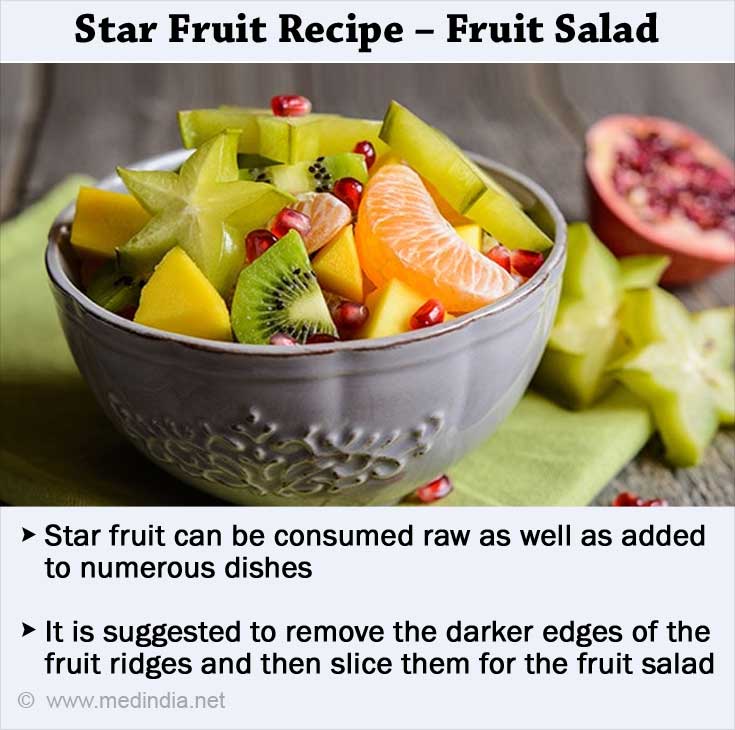- Experts from Dole Food Company, Mayo Clinic and UCLA Center for H. Encyclopedia of Foods: A Guide to Healthy Nutrition. 1st ed. USA: Academic Press Inc; 2001. 516
- Sweet poison: Star fruit neurotoxin identified - (http://phys.org/news/2013-11-sweet-poison-star-fruit-neurotoxin.html)
- Badhan Biswas, Md. Yeasir Arafat, Md. Shahadat Hossain, Md. Sakib-uz-Zaman, Zubaida Khatun, Mohammed Rahmatullah. Ethnomedicinal Practices of a Village Folk Medicinal Practitioner in Faridpur District, Bangladesh. American-Eurasian Journal of Sustainable Agriculture Jan 2014, p20, 8 p.
- Chi-Fai Chau, Chien-Hung Chen, Ching-Yi Lin, Insoluble fiber-rich fractions derived from Averrhoa carambola: hypoglycemic effects determined by in vitro methods, LWT - Food Science and Technology, Volume 37, Issue 3, May 2004, Pages 331-335, ISSN 0023-6438 - (http://dx.doi.org/10.1016/j.lwt.2003.10.001)
What is Star Fruit?
The carambola, better known as the ‘Star Fruit’, is an exotic tropical fruit that has traditionally flourished in Southeast Asia. Today, this fruit is available in most parts of the world as it is not just exported, but is also grown in other regions.
The fruit is almost oval in shape and has a shiny, waxy surface that has a greenish, yellowish hue. The flesh of the fruit also has a yellow color although it could vary greatly from dark to light shades. The surface of the fruit isn’t smooth, but it has lobes or ridges that run lengthwise. Because of these ridges, when sliced crosswise the fruit yields distinctly star-shaped slices.
The crunchy and juicy fruit is very popular in Southeast Asia, where it has grown traditionally. The fruits typically contain around 10 to 12 seeds, which are edible as well. Depending on the variety of carambola or star fruit, the flesh may be sweet or bitter, but both varieties are widely consumed. The fruit has a crisp and crunchy texture that adds to its appeal. According to most experts, the best quality fruits would be the ones that are allowed to ripen on the tree. While the fruit starts out green, it becomes distinctively yellow as it ripens.
The star fruit is easily susceptible to damage and is best eaten fresh. Under humid conditions, the fruit can even be stored for about three weeks in a refrigerated environment without any loss of quality. If kept at room temperature, fruits that have not yet ripened will also turn yellow. If you want them ripened, do not refrigerate until the fruit has turned yellow. Although the fruit can be frozen, preserved or pickled, it is the sweet variety that is eaten fresh which is most popular. You can eat it whole or slice it.
The bitter or tart variety is usually preferred for jams. If you can’t buy the fresh fruit you can even opt for juiced, dried, preserved or canned varieties of the fruit.
Health Benefits of Star Fruit
Like most other fruits, the star fruit does offer a number of health benefits.
- Star fruit juice is widely used in traditional and folk medicine in the Indian subcontinent. In parts of India and Bangladesh the juice of the fruit is used to treat fever and certain other infections. According to some practitioners of Ayurveda, the fruit can also be used in its ripe form as a digestive aid and tonic.
- The fruit is also used in traditional medicines to treat a variety of ailments from coughs and throat infections to diarrhea, food poisoning and toothaches. While the efficacy of star fruit as a panacea for all ailments is unlikely, there is no denying that it does offer several health benefits and researchers are currently investigating potential medicinal uses of the fruit and its extracts.
- The use of carambola or star fruit for diabetes or pre-diabetes may be helpful as a study published in 2004 suggests that the high fiber content of the fruit demonstrates certain hypoglycemic properties that may help regulate blood glucose levels.

- Star fruit is very rich in polyphenolic antioxidants like quercetin, epicatechin, vitamin C and even beta carotene. Antioxidants are natural substances that are found in foods, primarily in fruits and vegetables, but they can also be manufactured synthetically. Antioxidants are extremely important because of the protective action they offer against some types of degenerative cell damage because of free radicals. This of course doesn’t make the fruit some sort of miracle cure, but it would still be a good idea to include it in your diet, especially if you are at risk of degenerative conditions like cancer, Alzheimer’s and so on.
- Preliminary studies into the gastric anti-ulcerogenic effects of star fruit have been promising and indicate that extracts from the fruit may, in fact, help treat gastric ulcers because of a protective effect they have of the beneficial gastric mucosa.
- There may also be some merit to the use of star fruit for skin conditions, as the findings of a study that appeared in Evidence-Based Complementary and Alternative Medicine indicate that the fruit contains certain anti-inflammatory properties that could offer relief in some cases.
- The high fiber and low-calorie content of the star fruit makes it the ideal ingredient for any weight loss diet.

- The use of star fruit for hypertension and heart patients may also help as some natural health enthusiasts suggest that the fruit has a cholesterol-lowering effect. No matter what the mechanism of its action, some studies do suggest that the fruit could actually offer hypotensive benefits to heart patients.
Star Fruit Recipes
Star fruit can not only be consumed raw, but it can also be used in numerous dishes. Before using the fruit, however, remove the darker edges of the ridges and then slice the fruit crosswise. After slicing the fruit you can apply a bit of salt onto the flesh to prevent darkening. These fruit slices can be used to garnish a variety of foods and it can be added to salsa, dips, salads, pickles and chutney. You can even use the slices on skewers with cottage cheese, shrimp or chicken. Here are some recipes that you can use to incorporate the fruit in your diet:
Carambola Fruit Salad
Ingredients:
- 1 Carambola (seeded and sliced)
- 1 Orange (peeled and sliced)
- 1 Apple (sliced)
- Lime juice (1 lime)
Preparation
Simply mix all the fruits together with lime juice and serve it cold. You can even add or replace some of the fruits, depending on your personal preferences. Bananas and pineapples are popular additions to the mix.

Carambola Pie
Ingredients:
- Ripe carambolas (1 quart and sliced)
- Sugar (1 cup)
- Quick cooking tapioca (Quarter cup)
- Butter or margarine (2 tablespoons)
- Nutmeg (A pinch or more, as per your preference)
- Pastry (2 pie crusts)
Preparation
Get rid off the seeds from the fruit and cut into half-inch slices. Mix the tapioca and sugar well and then add the fruit. Mix it once more and then spread the mixture over the pastry in a 9-inch pie pan. Once you’ve done this you can sprinkle nutmeg over the dish and dot it with a few small pieces of butter. After this you can roll the 2nd pastry over the top, making sure it seals the ingredients in. Make a few gashes in it, so as to allow for the escape of steam. The dish is now ready to bake. Ideally, you should use a pre-heated oven at about 425°F. Allow the pie to bake for a little over half an hour or until you notice the top turn golden brown.
Cautionary Advice
We tend to take for granted that most fruits and vegetables pose no health risk because they are natural. While this may be true to some extent, the excessive consumption of certain foods, no matter how healthy they might be, can pose a health risk. This is certainly the case with the star fruit.
The fruit poses a particular health risk to individuals who suffer from kidney problems because of a particular toxin that is present in it, along with high levels of oxalic acid. In such individuals, consumption of the fruit can result in what is known as ‘star fruit intoxication,’ a condition that includes symptoms such as nausea, vomiting, hiccups, confusion and convulsions. These symptoms tend to surface within an hour or even five hours after consumption of the fruit.
Researchers initially suspected the high levels of oxalic acid in star fruit as being the culprit as oxalate can accumulate in weakened kidneys, but this does not occur with other oxalate-rich foods like spinach. Brazilian researchers investigated this effect and found that an unknown toxin present in the fruit causes these symptoms. While healthy adults have no problem excreting the toxin, the combination of oxalate and the toxin can be deadly to anyone with impaired kidney function. Researchers have since then, gone on to isolate and identify the toxin, christening it caramboxin. This neurotoxin is an amino acid-like phenylalanine.
If it does so occur that you notice any of the symptoms of star fruit intoxication after consuming the fruit make it a point to seek immediate medical attention.








